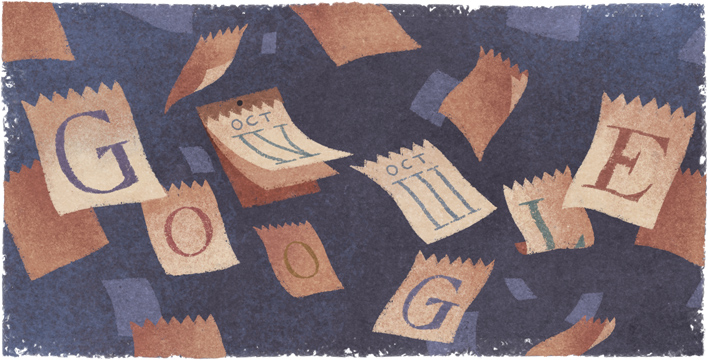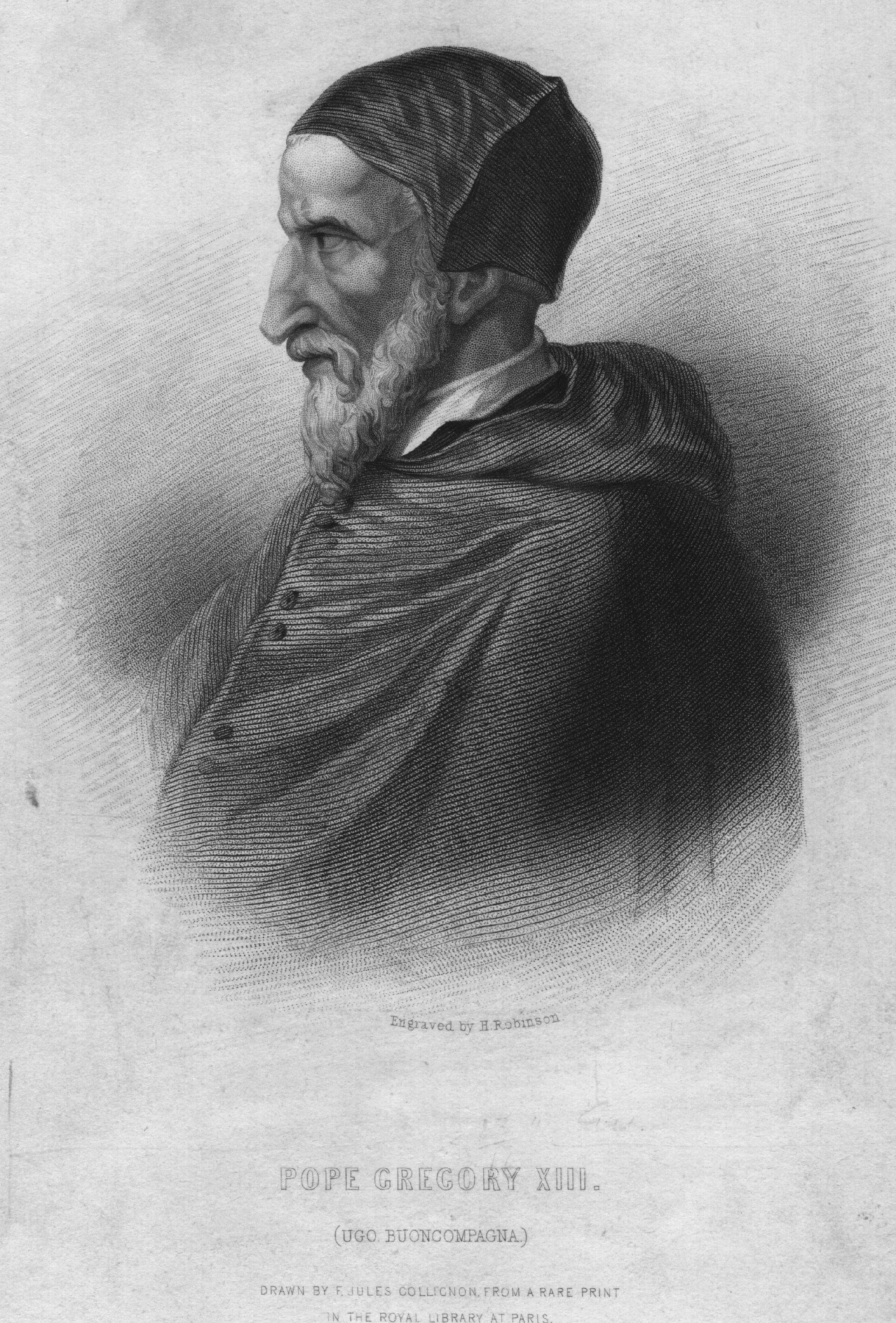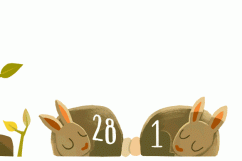
(Google)
The 434th anniversary of the introduction of the Gregorian calendar is being celebrated with a Google Doodle on October 4, 2016.
It was introduced in 1582 and has become the most widely used civil calendar in the world.
Here’s what you need to know about the calendar:
1. It Is Named for Pope Gregory XIII, Who Introduced It as a Refinement of the Julian Calendar

Circa 1583, Pope Gregory XIII who introduced the reformed Gregorian calendar. (Photo by Hulton Archive/Getty Images)
Pope Gregory XIII is the namesake of the calendar, after he called together a committee to refine the Julian calendar, which was in place at the time, according to the Religious News Service:
In 1582, Pope Gregory XIII promoted the use of a calendar originally calculated by an Italian astronomer, Aloysius Lilius, and tweaked by a Jesuit mathematician, Christopher Clavius. The calendar’s innovation was to shave just under 11 minutes off the year, making it 365 days, 5 hours, 10 minutes and 48 seconds long. That is offset by the addition of one day every four years, in years divisible by four, with the exception of century years — unless they are divisible by 400.
According to History.com, the original goal of the calendar was to change the date of Easter.
“In 1582, when Pope Gregory XIII introduced his Gregorian calendar, Europe adhered to the Julian calendar, first implemented by Julius Caesar in 46 B.C. Since the Roman emperor’s system miscalculated the length of the solar year by 11 minutes, the calendar had since fallen out of sync with the seasons,” the website says. “This concerned Gregory because it meant that Easter, traditionally observed on March 21, fell further away from the spring equinox with each passing year.”
2. The Adoption of the Calendar Faced Some Resistance, Including From Protestants & Landlords

Circa 1580, Pope Gregory XIII. He introduced the reformed Gregorian calendar. (Photo by Hulton Archive/Getty Images)
The calendar was initially opposed by some, including Protestants who were worried it was a trick to get them to convert to Catholicism and landlords who thought they were being cheated out of a week of rent, according to the Religious News Service.
History.com explains why it took so long for everyone to catch on:
Though Pope Gregory’s papal bull reforming the calendar had no power beyond the Catholic Church, Catholic countries—including Spain, Portugal and Italy—swiftly adopted the new system for their civil affairs. European Protestants, however, largely rejected the change because of its ties to the papacy, fearing it was an attempt to silence their movement. It wasn’t until 1700 that Protestant Germany switched over, and England held out until 1752. Orthodox countries clung to the Julian calendar until even later, and their national churches have never embraced Gregory’s reforms.
Some say rioters took to the streets in Britain when the calendar was put in place, demanding they get their 11 days back from the government, according to History.com.
3. The Gregorian Calendar Includes a Leap Day, a System That Dates Back to Ancient Times
The Gregorian calendar improved and kept the leap day system, which dated back to ancient Rome and Greece. The leap day occurs to keep our calendar in sync with the Earth’s rotation around the sun.
You can watch scientist Neal deGrasse Tyson explain the leap day to National Geographic in the video above or by clicking here.
“We on Earth, as we orbit the sun, we know how to calculate a year,” he says. “It’s how long it takes to come back to where you were, that’s a year. But it turns out if you cut the number of days we live into the year it doesn’t divide evenly. So there’s not an even number of days in the time it takes for the Earth to go around the sun.”
To keep the calendar organized, there are some rules that call for the leap day to be skipped during certain four-year periods, according to TimeandDate.com.
According to the website, to be a leap year, it must be able to be evenly divided by 4. If it it can’t be divided by 100, it is not a leap year, unless the year is also evenly divisible by 400. So, the years 2000 and 2400 are leap years, while 1800, 1900, 2100, 2200, 2300 and 2500 are not.
4. There Was Once a February 30 — in Sweden & Finland During the 1700s
The switch to the Gregorian calendar caused a headache for Sweden and Finland, according to Britannica.com:
When the Swedish were changing from the Julian calendar to the Gregorian, however, they ended up with a February 30. Most countries, in making the switch, sacrificed a whole row of days. The Swedish plan was to make the change gradually, by omitting leap days for 40 years. It was a good plan, if a long one, but ended up being implemented incorrectly because of the Great Northern War. In 1712 the Swedes decided to just restore the Julian calendar by adding the leap days they had taken out, and they ended up with 28 + 2 days in February. Several decades later the Swedish converted to the Gregorian calendar in the usual way, by taking out the last 11 days of February 1753.
As i09’s Alasdair Wilkins points out, that meant there were some babies born on February 30.
“It’s not easy to get really solid birth rate data for Sweden in the early 1700s – believe me, I’ve tried – and it’s even harder for Finland. But my guess would be that there were probably between 100 and 200 babies born in Sweden and Finland on February 30, 1712,” Wilkins writes. “That’s 100 to 200 people who, no matter how long they lived, never got to celebrate so much as their first birthday, which makes those born on February 29 look positively spoiled for birthdays by comparison.
5. Several Attempts to Reform the Calendar Have Failed
There have been several attempts made to reform the Gregorian calendar over the centuries since it was introduced, but all have failed, according to Stratfor.com, a global intelligence company which analyzed the geopolitics of the calendar in 2014:
Today, the Gregorian calendar’s shortcomings have translated into substantial losses in productivity for businesses in the form of extra federal vacation days for employees, business quarters of different sizes and imperfect year-on-year fiscal comparisons. The lack of consistency across each calendar year has also created difficulties in financial forecasting for many companies. …
Reform attempts have not been confined to hobbyists, advocates and academics. In 1954, the U.N. took up the question of calendar reform at the request of India, which argued that the Gregorian calendar creates an inadequate system for economic and business-related activities. Among the listed grievances were quarters and half years of unequal size, which make business calculations and forecasts difficult; inconsistency in the occurrence of specific days, which has the potential of interfering with recurring business and governmental meetings; and the variance in weekday composition across any given month or year, which significantly impairs comparisons of trade volume since transactions typically fluctuate throughout the week.
The most recent attempt to reform the calendar was introduced in 2011 by astrophysicist Richard Conn Henry, a former NASA employee who is now a Johns Hopkins University professor. He teamed up with economist Steve Hanke to create the Hanke-Henry Permanent Calendar.
But the Gregorian calendar is still being adopted up to this day. Saudi Arabia decided on October 1 to switch to the calendar as a cost-saving measure, according to The Independent.
The change strips away 11 works days from civil servants.
You can now view this content in Spanish on our sister site, AhoraMismo.com:




